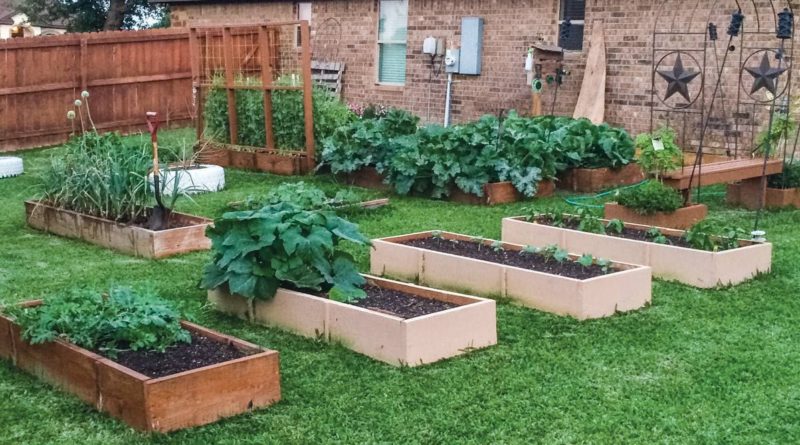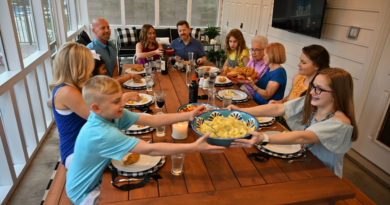A Higher Flower
Story by Valerie L. Valdez
Photographs by Karin Markert
Congratulations on your decision to start a raised vegetable garden! The weather has been enticing you to get your hands dirty, and you’re ready to get started, so what’s next? Ask Curtis Hunter for advice. A Killeen resident and a self-taught raised garden expert, Hunter built and maintains an impressive garden in his backyard.
To say that Hunter was born with a green thumb is an understatement. He also was born with a contractor’s thumb, and both give him the diverse skills to tackle most garden and building projects. A native of Seattle, Curtis Hunter built homes before joining the Army in 2005 as a combat engineer. Injuries ended his military career, leaving him with plenty of time on his hands. Never the type to sit still for long, he soon discovered the power of gardening to be both rewarding and therapeutic.
His first project was to build a wisteria trellis with small planters on each end. Through trial, research and some error, Hunter planted his first raised vegetable garden in 2014. It became prolific beyond his dreams, feeding other families even before his own. “We have a rule in my family, that whatever grows first, we give away to friends and family, and then we eat or can the rest,” Hunter said.
Last year, Hunter’s garden yielded 150 cucumbers for pickles, 50-60 zucchini, 40 yellow squash, 75 green peppers, about 150 cayenne peppers and a lot of tomatoes. “It was a good year,” he said.
He intentionally keeps his raised-garden concept simple, making it easy to manage. “First, find out what you want to grow and eat and then try to modify the space you have to fit raised beds in your yard, even if it means growing vegetables vertically by adding a trellis to the back of the bed,” Hunter advised. “Next, know what’s good for the climate you live in and for the season you want to plant, whether in the spring and summer, or year-round.”
There is no standard size for homemade raised beds. Hunter constructed 12 raised beds made from untreated Douglas Fir wood, with each bed measuring about 7 feet by 3 feet, filling each one to the top with soil. He said that he chose untreated lumber knowing he will have to replace the Douglas Fir beds in about five years, because he prefers not to use chemically treated wood.
He gets all his dirt from Bell County Compost because “it’s rich dirt, and cheap,” Hunter said. This year he removed the top layer of soil and filled the beds with new soil. Since the soil is already nutrient rich, he uses store-bought fertilizer sparingly. He also tests the soil with a simple four-way analyzer that measures its Ph balance.
Hunter recommends over-planting in each bed, too. “If several plants don’t survive, you still have enough plants to harvest,” he said. He buys seeds from Belton Feed & Seed and keeps them separate and labeled in plastic containers.
Like many gardeners, he starts the seeds in small cups in late winter until warmer weather arrives, then plants the seedlings.
Hunter’s “bible” is a large three-ring binder containing all his garden research with multiple sections, such as pest control, different planting zones (Central Texas is in Zone 8), and information on companion plants that grow well in the same bed.
“Cucumbers grow well with strawberries, but they won’t grow well with onions and garlic; if you plant sunflowers with the ‘cukes, they will grow sweeter,” Hunter said. He offered another tip: “If you want hotter-tasting bell peppers, then plant cayenne peppers in the same raised bed with them.”
To keep birds and squirrels out of his garden, he feeds them corn in small cups and bird feeders that he places away from his garden. About 30 different types of vegetables grow in his raised beds, including varieties of vegetables, such as two different types of broccoli, and five kinds of lettuce and spinach. In all, his planted garden spans 116 square feet.
One clever idea Hunter has discovered for a vertical herb garden is to make use of rain gutters. “I had several rain gutters cut into 5-foot sections and put end caps on each section. Then, I hung them in rows on one part of the back fence, filled them with dirt, and planted different herbs in each gutter section, like rosemary and thyme,” he said.
As an advocate of simple gardening methods, Hunter controls most pests with diatomaceous earth and a homemade mixture of a little Dawn dish soap with water that he sprays on the bugs.
A common question he is asked is how much it costs for someone to start a small raised-bed vegetable garden. Hunter estimates that the initial costs for making several raised beds are not too expensive — little more than $100 to build two beds, including lumber and landscaping fabric stapled to the bottom to keep weeds from growing, and compost material.
In less than two years, Hunter is not only growing healthier vegetables, but envisioning a new future for himself and other veterans. He is exploring the idea of starting a veterans’ garden to share its therapeutic benefits.
“Gardening is a good outlet that builds confidence,” he said. “People could get the companionship of being with other soldiers while growing something good to eat.”


